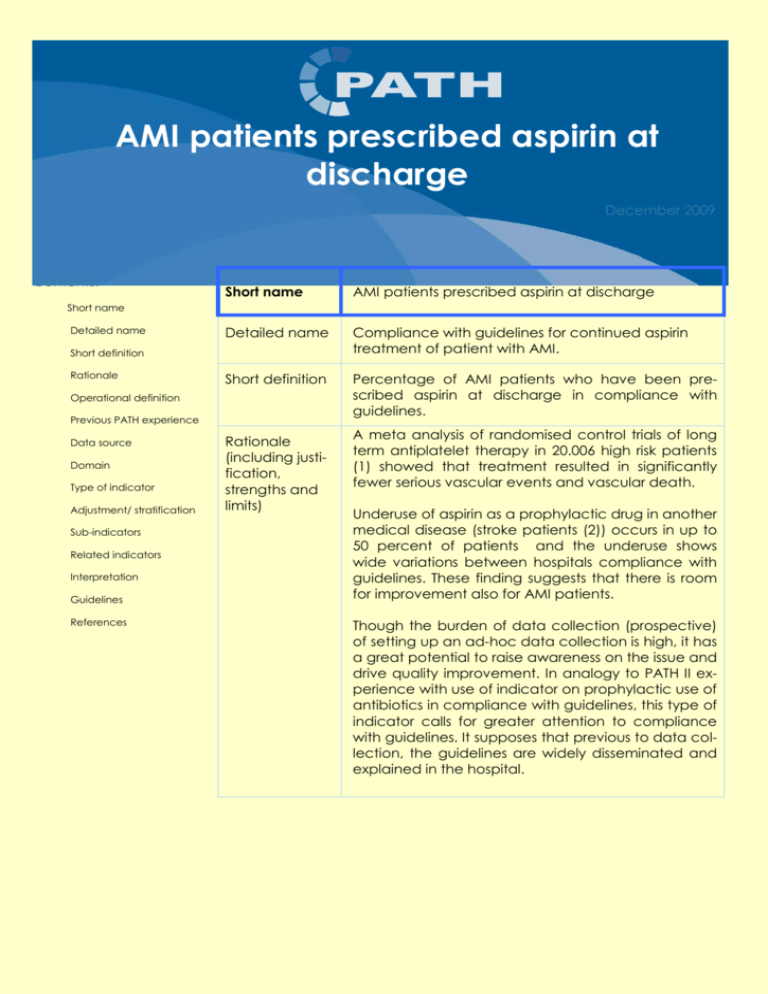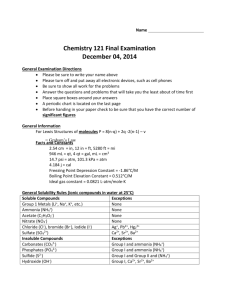9_AMI patients prescibed aspirin at discharge
advertisement

AMI patients prescribed aspirin at discharge December 2009 Contents: 1. Short name AMI patients prescribed aspirin at discharge 2. Detailed name Compliance with guidelines for continued aspirin treatment of patient with AMI. 3. Short definition Percentage of AMI patients who have been prescribed aspirin at discharge in compliance with guidelines. Short name Detailed name Short definition Rationale Operational definition Previous PATH experience Data source Domain Type of indicator Adjustment/ stratification Sub-indicators Related indicators Interpretation Guidelines References 4. Rationale (including justification, strengths and limits) A meta analysis of randomised control trials of long term antiplatelet therapy in 20.006 high risk patients (1) showed that treatment resulted in significantly fewer serious vascular events and vascular death. Underuse of aspirin as a prophylactic drug in another medical disease (stroke patients (2)) occurs in up to 50 percent of patients and the underuse shows wide variations between hospitals compliance with guidelines. These finding suggests that there is room for improvement also for AMI patients. Though the burden of data collection (prospective) of setting up an ad-hoc data collection is high, it has a great potential to raise awareness on the issue and drive quality improvement. In analogy to PATH II experience with use of indicator on prophylactic use of antibiotics in compliance with guidelines, this type of indicator calls for greater attention to compliance with guidelines. It supposes that previous to data collection, the guidelines are widely disseminated and explained in the hospital. PAGE 2 AMI PATIENTS PRESCRIBED ASPIRIN AT DISCHARGE 7. Operational definition Numerator Number of patients at the denominator (meeting the inclusion and exclusion criteria) - in compliance with guidelines on long term prophylactic use of aspirin in AMI patients. At discharge patients are provided with a prescription on aspirin in accordance with guideline. A national guidelines are to be defined in details within the PATH national group of participating hospitals based on international guidelines tailored to local working procedures. Denominator Number patients admitted to hospital, age 15 years and older, with the principal/primary diagnoses of acute myocardial infarction (AMI): ICD-9: 410 ICD-10: I21, I22 Exclusion - Transferred to another in-patient hospital - Allergy to aspirin - Patient not given informed consent to aspirin treatment - Patient left hospital against medical advice - In hospital death A Prospective Data Collection Form (Appendix A) and an Indicator Computation Algorithm (Appendix B) are provided with this indicator descriptive sheet to support uniform data collection and calculations in accordance with the operational definitions. 8. Previous PATH experience Not applicable 9. Data source Prospective data collection continuously for at least two periods a year (e.g. starting February and October, minimum number of cases 30 per period). It should be repeated at least every 6 months to sustain awareness to continuous improvement in compliance with guidelines. The prospective data collection form is to be enclosed in the patient records for all eligible patients with the below listed procedure and diagnostic codes. It should be discussed and agreed within the PATH national group on a common procedure to make sure that all relevant patients get the Prospective Data Collection Form into their record, that it is filled in (by whom, and when) and that the forms, when filled in, are collected centrally in the hospital for the necessary calculations and reporting to be established. All the fields in the prospective data collection form are to be electronically encoded by the hospitals on a common structure (file) to be provided by the PATH coordinator in the country (e.g. Excel sheet or EPI Info). The database is then sent to the PATH coordinator in the country to validate the classification in “buckets” and compute indicators. 2 AMI PATIENTS PRESCRIBED ASPIRIN AT DISCHARGE 10. Domain PAGE 3 Clinical Effectiveness Safety 11. Type of indicator Process measure 12. Adjustment/ stratification Not relevant 13. Sub-indicators The percent of patients with missing/ incomplete data should also be computed to monitor and assess the data quality (Appendix A). 14. Related indicators The following indicators are not computed in the frame of PATH’09 but if monitored in the hospital, it might be relevant to relate to rate of AMI patients prescribed aspirin at discharge: Measurement of compliance with other Grade A evidence treatments for AMI, e.g.: 15. Interpretation - Early aspirin treatment - Early ACE (angiotensin-converting enzymes) inhibitor - Re-admittance rates Improvement is noted as an increase in the rate of compliance. A near 100% compliance rate should be sought. Variations between different hospitals can be caused by different financial incentives for the use of aspirin, differences in the hospitals autonomy to order drugs and differences in the effectiveness of dissemination of the clinical guidelines (3). The process-owners for prescribing of aspirin at discharge may include doctors, nurses, pharmacists and support staff on the nursing unit. Opportunities may exist in any of these arenas which, when addressed jointly, can generate true process improvement. 16. Guidelines 18. References 17. http://www.nice.org.uk/nicemedia/pdf/CG48FullGuideline.pdf (1) Baigent C, Sudlow C, Collins R, Peto R. Collaborative meta-analysis of randomised trials of antiplatelet therapy for prevention of death, myocardial infarction, and stroke in high risk patients. Br Med J 2002; 324(7329):71-86. (2) Ingeman A, Pedersen l., Hundborg, H. H. , Petersen, P., Zielke,P., Mainz,J., Bartels,P. and Johnsen S.P. Quality of Care and Mortality among Patients with Stroke: A Nationwide Follow-up Study. Medical Care 2008;46: 63-69. (3) Grimshaw JM , Thomas RE, MacLennan G, Fraser C, Ramsay C, Vale L et al. Effectiveness and efficiency of guideline dissemination and implementation strategies. Health Technology Assessment. 2004; 8(6). 3






